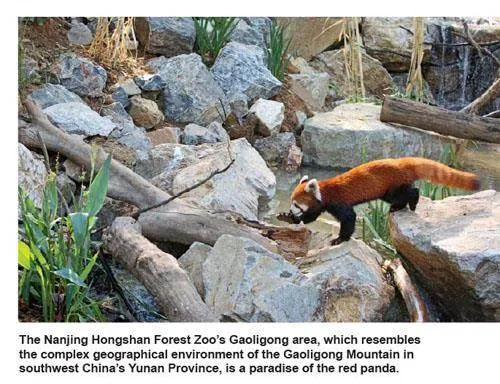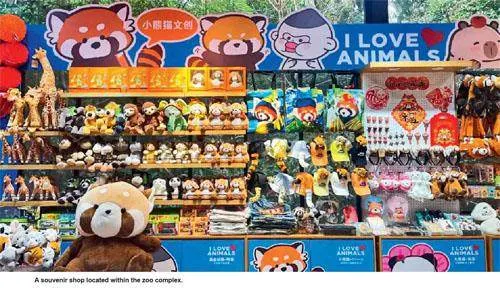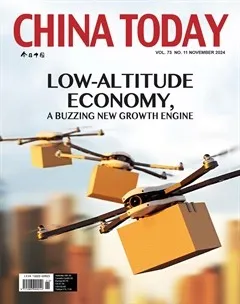Gen Z Turns Frequent Zoo Goers


THROUGH allowing visitors to watch capybaras, themost loved online animal celebrity now in China, takea bath and telling the background stories of each animal,various zoos in China are using innovative waysto create a new paradise for young urbanites to escape fromthe hustle and bustle of everyday life, as viewing cute animalscan calm their minds and relax their nerves. In China, strollingthrough a zoo has become a trendy way for the young generationto enjoy their leisure time.
Conventional No More
“I went there specifically to see Jasmine the koala. Since thezoo opened at 8:30 in the morning, I made sure to arrive thereat 7:30 to queue up to be part of the first group to watch thekoalas being weighed,” said Liu Keni, a college student fromNankai University in Tianjin. She was still very excited as sherecalled her visit to the Hongshan Forest Zoo in the city ofNanjing.
From a paradise for children to a must-visit place for youngpeople to come close to nature, this forest zoo is undergoingan identity transformation. “I read lots of posts about it on socialmedia platforms before and was fascinated by the imagesof cute little animals. I felt quite comfortable and relaxed beingthere,” said Liu.
Nowadays, visiting zoos is becoming trendy among China’sGen Z. Many say that they “have a mania for zoos”. Data fromthe ticket center of the Nanjing Hongshan Forest Zoo showthat, since 2024, the age group of 20-30-year-olds has becomedominant, accounting for 61.91 percent of the total ticket purchasers.The zoo, which was once a destination mainly for localchildren, has been seeing a significant demographic changein its visitor structure.
For some people, merely visiting the zoo is not satisfyingenough, and they have applied to become a “zookeeper.”Huang Yinuo is an example of this. Huang is a young womanof the post-05 generation (referring to those born after 2005),and is now a volunteer docent at the Hongshan Forest Zoo,responsible for popularizing scientific knowledge and maintainingorder in the zoo. She has been working there for over ayear and has adopted a koala named Jasmine.
“Volunteer work has given me a deeper understandingof animal protection and ecological conservation. I now paymore attention to how we should coexist with nature. I hopeto continue participating in such volunteer work in the futureto contribute what I can to animal protection and ecological"education,” said Huang.
For many young people today, visiting a zoo gives them afeeling of coming close to and exploring nature. Not only canthey take photos and mark off the popular places they havevisited, but they can also gain many novel experiences andfind emotional healing. As the concept of harmonious coexistencebetween humans and nature is deeply rooted in thehearts of many Chinese, visiting the zoo has become a popularlow-cost way to get closer to nature. As a big fan of animals,Liu told China Today , “I have also been to zoos in Tianjin, Beijing,and other places. I would like to participate in more zooactivities in the future.”
Immersive Experiences in a Zoo
In the 600-square-meter red panda hall at the HongshanForest Zoo, thick trees grow wantonly, and several red pandaswith fluffy red tails spend their time climbing up and down everythingthey see. Many visitors stop in front of the glass wall.“Red pandas are small. I had to look for them for some timebefore I finally found them in the treetops. I never knew thatthey could climb up so high!” Liu said.
The design of the red panda area demonstrates the advancedconcept of simulating the ecological environment ofwild habitats for wild animals. It breaks away from the traditionaltaxonomic concept and innovatively implements theconcept of ecological geography to put non-rivalry animals inthe same habitat, showing visitors the original lifestyle of wildanimals in the southwestern mountains of China.
By enriching the natural environment of the exhibition area,the zoo tries as much as possible to create a real natural living"environment for the animals, allowing them to grow and roamfreely and comfortably, while providing visitors with an immersivenatural exploration experience. Shen Zhijun, the zoodirector, described the construction concept of the zoo, “Wecarefully designed the living environment for animals, fromoptimizing the living space to improving their overall environment.We’ve improved both the animals’ sleeping quarters andgardens where they play. Besides, we also improved the medicaland nutritional services to ensure the overall well-being ofthe animals.” This design exhibiting the humanistic care foranimals has deeply touched the hearts of many visitors.
Adhering to the principle of respecting life and revering nature,Hongshan Forest Zoo’s administration focus their effortson animal rescue and conservation, striving to help animalslive a happy life while in the confines of the zoo. The zoo hasalso launched a cloud adoption program through online livebroadcasts, written stories for each individual animal, published“family letters” and obituaries for animals, all in an effortto bridge the gap between visitors and work in the zoo.
“It is a dialogue between one life and another,” Shen said.“We want to disseminate the concept of harmonious coexistenceto the public in a professional manner, inspire the public"to think about the relationship between humans and nature,and encourage them to participate in ecological conservationin practical ways.”
“Zoo +” Drives New Business Models
Today, zoos have been transformed into new landmarks ofa fashionable life. Under the concept of “Zoo +,” they have becomea multi-functional complex integrating education, scientificresearch, entertainment, social interaction, and ecologicalconservation. As a result, zoos are beginning to boom again.
In June 2024, the National Development and Reform Commission(NDRC) and other departments issued the Regulationson Creating New Consumption Scenarios and CultivatingNew Growth Points of Consumption, which proposed to“cultivate a number of new consumption scenarios, promotea number of typical cases, support a number of leading consumercompanies in their development, and facilitate theemergence of new consumption formats, new models, andnew products, to stimulate the vitality of the consumer marketand corporations.” The transformation of zoos is in line withthe country's development direction.
In addition to creating innovative ways for visitors to in-teract with animals in Hongshan Forest Zoo, creative culturalproducts are also sold in its gift shops. There is a dazzling arrayof lovely commodities such as fashionable mobile phone cases,plush blind boxes, and DIY animal garlands that attract manytourists. “I spent RMB 40 on my entrance ticket to the zoo butspent RMB 400 shopping there” is how many Chinese netizensdescribe the magic of the zoo’s cultural and creative goods.
When people feel tired of walking around the zoo, theycan relax in the cafe nearby, order a cup of “Dudu” (name of awhite-faced saki monkey) coffee, and enjoy some quiet personaltime. There are stamps with animal patterns on the tablefor stamp collectors, and a glass window for those who wantto get closer to the cute animals. With these ingenious designs,the Zoo Coffee inside the zoo has already become a must-visitvenue.
It is evident nowadays that the zoos that attract young peopleare no longer conventional ones. They want to be fashionableand exhibit dynamic life scenes thatintegrate shopping, dining, socializing,study tours, exhibitions, and adventure.Zoos are expected to provide visitors withmore consumption choices and richer culturalexperiences.
Businesses have already spotted the opportunities.Co-branding is in vogue. Thisyear alone, Hongshan Forest Zoo launchedcollaboration with the popular milk teabrand Heytea, the famous cosmetics brandJudydoll, and environmentally friendlyclothing brands Klee Klee and HenryGrant. This demonstrates its brand building and market expansionabilities and also shows that the “Zoo +” model couldfare well in cultural tourism.
The popularity of this zoo has not only increased its revenues,but also created a unique IP for the city in which it islocated, creating a vibrant city image.
The giant panda Cheng He Hua (nicknamed Hua Hua)at the Chengdu Research Base of Giant Panda Breeding inChengdu, Sichuan Province, is another typical example of howzoos and animal conservation bases can use innovative waysto attract a new generation of visitors. Hua Hua has driventhe development of Chengdu’s cultural tourism with its owncharm. It was officially announced as the “Honorary Directorof Chengdu’s Culture and Tourism Bureau” in April 2024. HuaHua starred in a promotional video for the Chengdu 2021 FISUWorld University Games and appeared on the big screen inTimes Square in New York. Not only did she drive regional economic development, she also became an animal diplomat forChengdu and China.
While creating economic benefits by attracting morevisitors, the zoo can also fulfill its social responsibility andecological mission by raising public awareness of sustainabledevelopment through organizing public activities. Many zoostoday are serving as science education bases. Through livebroadcasts of animals, study tours, and other activities, theyeducate visitors about animal protection. They also rescuewild animals and provide them with a shelter. Besides, theyact as a bridge for enterprises and individuals to organize andparticipate in animal protection projects, as a way to shouldertheir ecological responsibilities. This “Zoo + ecological conservation”model conveys to the public that people should carefor wild animals and protect the ecological environment forthe harmonious coexistence between humans and nature.
Today, zoos and animal conservation centers across Chinaare telling China’s own animal conservationstories on the international stage.
For example, Hongshan Forest Zoo hashosted international exchange activitiessuch as the Nanjing leg of the Global YoungLeaders Dialogue (GYLD) China Tour andthe Global Youth Practice Camp. It has alsoorganized exchange programs with theUnited States, Australia, Europe, and othercountries and regions, showing the worldChina’s innovative practices and achievementsin animal protection.
Behind the success of these star zoos,there are still many large and small zoos across China facingdifficulties such as few visitors as a result of outdated facilitiesand lack of funds, which urgently need to be solved. Therefore,exploring diversified development paths and achieving a winwinsituation between conservation and development is theonly way for zoos to be transformed and upgraded.
Zoos are a unique bridge connecting humans and nature.The exploration and practice of the “zoo+” model by zoos,wildlife parks, and animal conservation bases across Chinanot only inject new vitality into the development of the zoosthemselves, but also provide a useful reference for promotinggreen and win-win development between ecology and economy.As people’s awareness of ecological and animal protectionincreases, the zoo industry needs to expand the model so thatprotection and development can go hand in hand.

